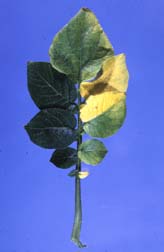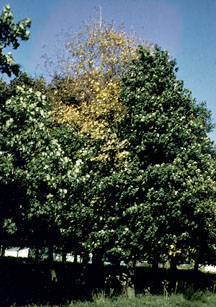Verticillium
A Microbial Biorealm page on the phylum Verticillium
Classification
Higher order taxa
Division Eucaryota, Kingdom Fungi, Phylum Ascomycota, Class Incertae sedis
Species
Verticillium dahliae
Verticillium lecanii
Verticillium albo-atrum
Description and Significance

"Verticillium is a filamentous fungus that inhabits decaying vegetation and soil. Some Verticillium species may be pathogenic to arthropods, plants, and other fungi. It is commonly considered as a contaminant. Verticillium may very rarely cause human disease."[1]
"Verticillium is also a genus of fungi of Ascomycota. This genus has three ecologically based group: mycopathogens, entomopathogens, and plant pathogens and related saprophytes."[7] The Verticillium belongs to the plant pathogens group.
Verticillim dehliae and Verticillim albo-atrum cause wilt diseases, which refers to loss of rigidity of non-woody parts of plants, in plants such as "cotton, potatos, peppers, eggplants, tomatoes, and ornamental woody plants"[7]. Because Verticillium species are soil-borne and can attack both herbaceous and woody plants, the Verticillium wilt is difficult to control.[4]

Microscopic Features
"Septate hyaline hyphae, conidiophores, phialides, and conidia are observed. Conidiophores are hyaline, simple or branched. The branching of the conidiophores occurs in whorls at several levels. Conidiophores bear the phialides. Phialides are very long and are also arranged in verticils (whorls) around the conidiophore. Verticils may be disrupted in slide culture. The apices of the phialides are pointed. Conidia (2-13µm in length) are hyaline or brightly colored, one-celled, and oval to pyriform in shape. They are solitary or form clusters in sticky heads at the tips of the phialides." [1][3][6]
Pathogenicity and Clinical Significance
"Verticillium has been reported as a possible cause of keratitis in humans. "[1][2][3]
References
1 http://www.doctorfungus.org/thefungi/verticillium.htm
2 Larone, D. H. 1995. Medically Important Fungi - A Guide to Identification, 3rd ed. ASM Press, Washington, D.C.
3 Sutton, D. A., A. W. Fothergill, and M. G. Rinaldi (ed.). 1998. Guide to Clinically Significant Fungi, 1st ed. Williams & Wilkins, Baltimore.
4 http://www.ext.vt.edu/pubs/plantdiseasefs/450-619/450-619.html
5 Larone, D. H. 1995. Medically Important Fungi - A Guide to Identification, 3rd ed. ASM Press, Washington, D.C.
6 St-Germain, G., and R. Summerbell. 1996. Identifying Filamentous Fungi - A Clinical Laboratory Handbook, 1st ed. Star Publishing Company, Belmont, California.